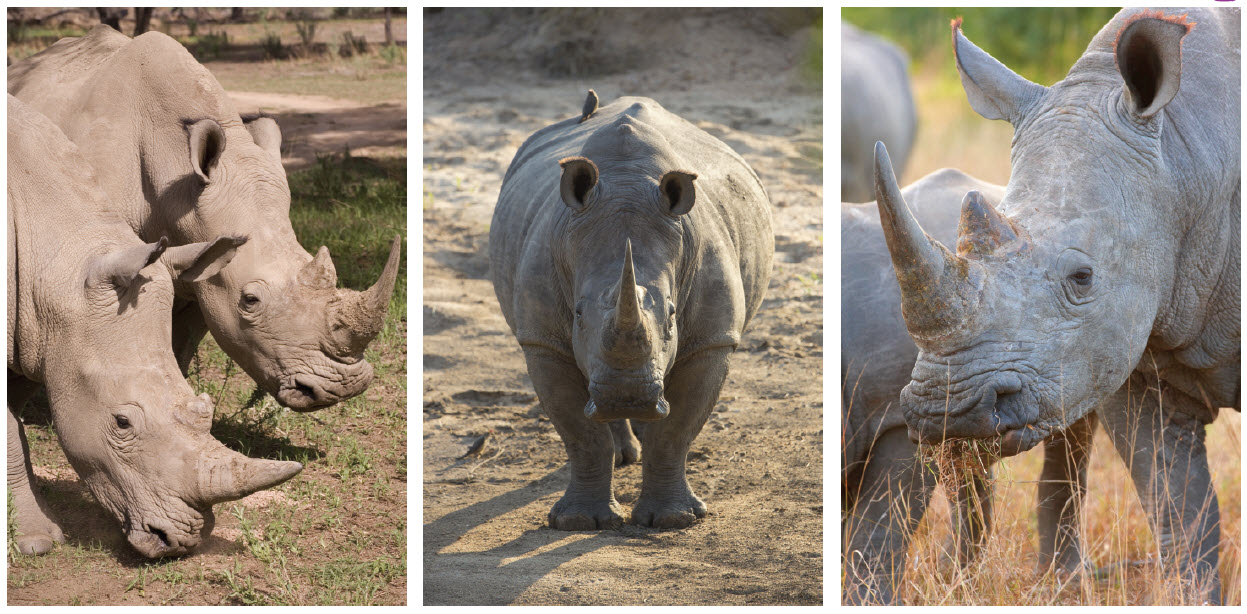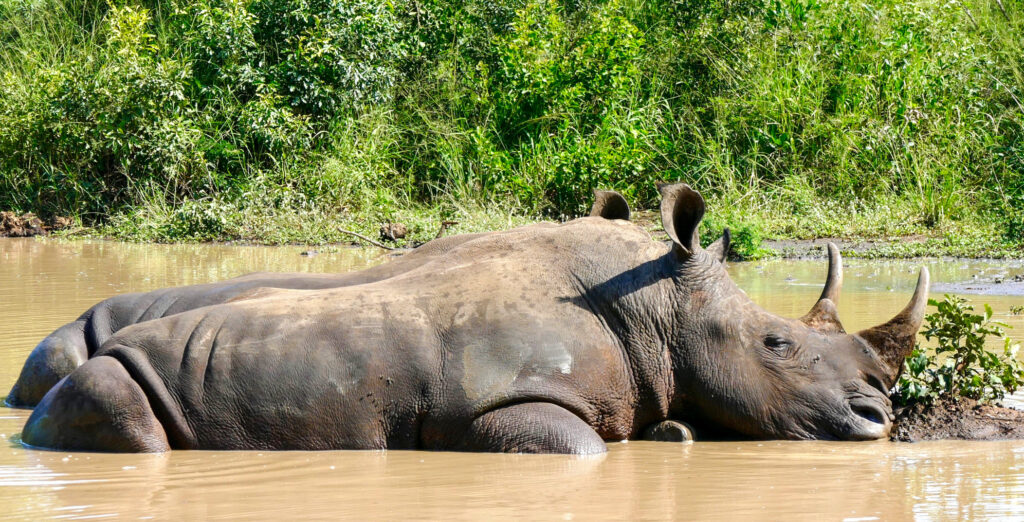THE RHISOTOPE PROJECT
Part three of a profoundly significant trilogy
“Science saving Rhinos. Rhinos Saving People. People Saving Rhinos.”
The creation of a new tribe has begun. Our totem is the rhino. And we are using people-power and nuclear technology in a wholly innovative way to help us try and save this magnificent species, as well as others, into the future.
Despite our shortcomings as humans, there is (thankfully) an ever-growing awareness that our very survival and wellbeing depend on a healthy and balanced natural world. Technology in and of itself is as ‘opposite’ from our natural world as you can get. Yet in all its facets, tech is increasingly becoming a life saver for all manner of fauna and flora, and their habitats, around the world.
The definition of the word ‘save’ is defined as: to keep safe or rescue something or someone from harm or danger. Thanks to visionary pioneers, both current and those who have gone before us, many species and habitats have been brought back from the brink of extinction. Much of this has been achieved through sheer will power, innovation, passion, communication, collective action and determination.
Enter rhinos.
For more than 50 million years, rhinos as a species have roamed this earth. Being megaherbivores, they have helped to create – and continue to support – a cascade of life that sustains and benefits a myriad of other species and their habitats. Rhinos were architects of the landscape then and continue to fulfil that vital role today. Rhino evolution pre-dates that of homo-sapiens. Their ancestors emerged shortly after the demise of the dinosaurs, long before hominids were featured in the evolutionary line.
Enter humans.
In terms of human evolution, which began around six million years ago, we are but a blip on the evolutionary landscape. Our entire existence on Earth has always been intimately entwined in all-natural rhythms, supplying us with everything we needed for daily life and survival. Our living planet has inspired and influenced our thoughts, creativity, inner wellness, spirituality, cultural structures and belief systems and continues to do so to this day.
Within the last few decades, our global rhino populations have been decimated. This is due to demand for their horns which serve as status symbols, for crafted and carved trinkets or jewellery, and for traditional medicinal and usage purposes. Traditional cultural beliefs in the main consumer countries of China and Vietnam have taken their toll on the few remaining rhinos of the five species left in the world.
As we have evolved and expanded, humans have become a powerful force for change and not always for the better. We continue to take more than we give back. Have we forgotten what it means to feel connected to the greater life force around us? And in what way are we feeling the effects? Today we live in a technological world that many feel has largely distanced us from what it means to be in tune with the natural rhythms of Life. We have become victims of our own success.
Or have we?
Enter technology.
Nuclear technology to be precise. Humans might be part of the problem, but we are equally part of the solution. Innovation is often born out of desperate need. And innovation is precisely what The Rhisotope Project is all about. Science saving rhinos. Rhinos saving people. People saving rhinos.
By placing small quantities of radioisotopes into the horns of rhinos, this elegant nuclear technology is about to become a conservation hero, changing the dynamics forever in terms of rhino safeguarding. The best part is there is absolutely no harm to the animal as there isn’t any movement of the compound from the horn into the body of the rhino. The results (of which) were conclusive in Phase 1 of the Project.
Five years ago, the possibility of using nuclear technology to help save a species was only a concept. Through The Rhisotope Project this is now becoming a reality. Although the realm of nuclear technology may mean almost nothing to rural communities – or consumers of rhino horns for that matter – this is about to change!
With the rhino as an ambassador species, we now have the ability to merge the power of nuclear technology with the power of philanthropy. With rhinos as living ambassadors, we can create meaningful change in the lives of people both in South Africa, Africa and around the world.
Many may ask why anyone would want to save a rhino – especially those in communities nearby, living on the edge of poverty. For most, a rhino is something very far removed from their sphere of daily survival. For some, poaching is a means of survival. This, however has the disastrous result of bringing the darkness of organised crime into otherwise peaceful communities.
Using the rhino as a symbol to bring benefits and empowerment to local people is key to deterring poaching and helping to create and sustain healthy, resilient communities. This is achieved by Rhisotope embarking on various philanthropic campaigns with local entities. By bringing benefits linked with rhinos into each home, village, and community and beyond, we can ensure a living rhino has more value than a dead one. People saving rhinos.
Equally, people who live in other parts of the world may only see a rhino as simply an animal that lives in Africa. The Dark Continent lies very far away from their daily realm of awareness or care.
The Rhisotope Project plans to change all that. A rhino does affect every human on the planet – no matter where you live. The reason for that is simple – black market crime. Black market crime adversely affects every person and community on the planet in one way or another.
Black market trades consist of four main pillars – weapons, drugs, wildlife trafficking and human trafficking. Where you find one, you will always find at least one other. It stands to reason that weapons are an intimate part of rhino poaching. After all, it is with illegal weapons that the lives of these magnificent creatures and others, are taken on a daily basis.
Rhino horn is the most valuable false commodity on the black market. Dollar prices fetch in excess of $20 000 per kilo. All manner of attempts continue to be made to try and stem both the demand and poaching, such as attempts to poison the horns (which was unsuccessful), through to dehorning. Research has recently shown that removing the horns, has a detrimental effect on the breeding and habitat range of black rhinos. Rhinos have needed their horns for millions of years and still do. But what choice do some have?
Many owners have been forced to sell their animals as they cannot afford the security required to protect them – a tragic disinvestment in the species. For others, seeing a living rhino without a horn is ultimately more preferable than seeing a rhino poached and savagely slaughtered.
The business of transnational crime is valued at roughly between $1.6 trillion to $2.2 trillion annually – if not more. Wildlife crime alone – featuring armed violence, corruption, money laundering and other forms of organised crime – is responsible for the eradication of plants, birds, marine life and mammals with trade value estimated at over $20 billion per year.
Take heart however in that the good guys are by no means sitting idle.
Crime fighting has many facets, however, especially when aided by placing nuclear technology into the horns of rhino. Rhisotope is able to benefit from a global multi-billion-dollar nuclear security infrastructure. How many people know that nuclear detection portal monitors exist at over 11 000 ports of entry around the world? In addition, there are thousands of personnel who are equipped with radiation detection monitors.
International nuclear security agreements are clear and specific. It is illegal for any unauthorised person or entity to be caught in possession of any nuclear or radioactive material under any circumstances. Anyone caught in possession of a horn/s treated by Rhisotope, or involved in part of a consignment will be prosecuted under much harsher laws and penalties. Thanks to Rhisotope technology, we are now able to turn what is currently a low-risk/high-reward enterprise, into a high-risk/low-reward endeavour.
And as for the end user, people’s innate fear of nuclear technology is designed to put them off entirely. Would any sane person want a radioactive horn decorating their desk? Or, for that matter, try to ingest radioactive material as ‘medicine’, or wear radioactive trinkets?
As The Rhisotope Project embarks on a journey to try and restore some sort of balance – we will continue to combine the latest technology with innovation, passion, exploration, compassion, courage and connectedness. Some of the most precious and innate qualities that set humans apart.
By uniting these and other powerful human capabilities and by celebrating the rhino as an ambassador species, we stand a chance of protecting the fragile, delicate balance that exists between man and nature, nature and man and what is needed to sustain each into the future.
Although there have been tremendously successful interventions when it comes to wildlife protection, it is not enough. There is much more to be done.
The Rhisotope Project needs your help. By saving rhinos we are able to save people too. The Rhisotope Project relies on people in order to succeed. People saving rhinos.
Whilst the criminals rake in massive amounts of cash, projects such as Rhisotope – as well as many others – do not have that cash-flow luxury. The single biggest challenge that has faced the Rhisotope Project has been to source the funds and investment needed to take each phase forward.
In addition, our pioneering partners such as Wits University, Texas A&M, Colorado State University, International Atomic Energy Agency, Nuclear Energy Corporation of South Africa, Australian Nuclear Science and Technology Organisation, Merrick and others, have all played a vital role in helping Rhisotope achieve this point of success. They will continue to do so.
The power of the global citizenry to help save rhinos, save people and fight crime at the same time should not be underestimated.
By reading this article, you have already become a rhino ambassador by simply learning about and understanding the species a little better and how rhinos play a role in all of our lives. To be a part of the awakening to the positive power of nuclear technology and how it is being applied to help save a species – and ourselves – at the same time, is a massive step forward.
- Science saving rhinos in the form of nuclear technology.
- Rhinos saving people by being an ambassador species that is linked with a better life.
- People saving rhinos in the form of collective philanthropic action and its benefits.
If you would like to find out more, or are interested in supporting any aspect of The Rhisotope Project, please feel free to contact us at: info@rhisotope.org and look at our website www.rhisotope.org
References
-
https://www.dffe.gov.za/mediareleases/creecy_relasesrhinopoachingstats2024feb27
-
Duthé, V. et al. (2023) “Reductions in Home-Range Size and Social Interactions among Dehorned Black Rhinoceroses (Diceros bicornis),” Proceedings of the National Academy of Sciences of the United States of America, 120(25)



